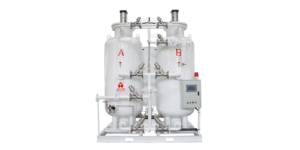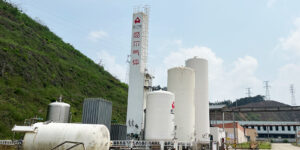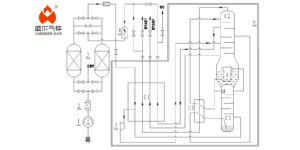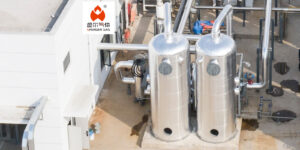This article will tell you the principles of air separation. The primary components of air are oxygen and nitrogen, which are uniformly mixed in molecular form. It is usually difficult to separate them, but there are currently three main methods used in the industry to achieve air separation.
Methods of Air Separation
1.Cryogenic Distillation
The cryogenic method involves compressing, expanding, and cooling the air until it liquefies. By exploiting the different boiling points of oxygen and nitrogen. Where nitrogen, with a lower boiling point, vaporizes more easily than oxygen. The mixture is subjected to repeated contact between warmer vapor and cooler liquid in a distillation column. This process causes the vapor to become increasingly rich in nitrogen while the liquid becomes richer in oxygen, thus separating the two gases.
The air must be cooled to a temperature of -173°C for liquefaction, a process known as deep freezing. The subsequent separation of liquid air into oxygen, nitrogen, and argon based on their boiling points is called rectification. This method is the most widely used in industry today.
2.Adsorption Method
This method utilizes the selective adsorption properties of porous materials, like molecular sieves, which can selectively adsorb different gas molecules. The adsorption separation process is straightforward, easy to operate, and cost-effective. Common techniques include pressure swing adsorption (PSA) and vacuum adsorption.
3.Membrane Separation Method
This method relies on the difference in solubility and diffusion coefficients of nitrogen and oxygen across a membrane under differential pressure. Gases with higher permeability, such as water vapor and oxygen. Passing through the membrane first, becoming enriched in oxygen. While the less permeable nitrogen remains and becomes enriched, achieving the separation of oxygen and nitrogen.
Basic Principles of Air Separation
The basic principle of air separation involves using cryogenic distillation to liquefy air and then separating it based on the different evaporation temperatures of its components. The process to produce nitrogen and oxygen for end users can be summarized in the following steps:

Air Compression and Filtration:
Atmospheric air is drawn in through an intake, where a self-cleaning air filter removes dust and other mechanical impurities. The filtered air is then compressed by an air compressor.
Air Precooling and Purification:
The compressed air, now at a high temperature, is cooled in an air precooling system via contact heat exchange. Which also washes out acidic substances and other harmful impurities. The molecular sieve purification system further removes water, carbon dioxide, and other harmful substances.
Air Separation:
The purified air enters the main heat exchanger in the air separation column. Where it is cooled to saturation temperature by reflux gases (product nitrogen and waste gas) and sent to the bottom of the distillation column. Nitrogen is obtained at the top of the column, while liquid air is sent to the condenser-evaporator to evaporate, partially condensing nitrogen from the distillation column. The condensed nitrogen serves as reflux liquid for the distillation column or as a liquid nitrogen product.
Waste Gas Processing:
Waste gas from the condenser-evaporator is reheated to approximately 130K in the main heat exchanger and expanded in an expanded to supply refrigeration to the air separation column. Some of the expanded gas is used for molecular sieve regeneration and cooling, with the remainder vented to the atmosphere through a silencer.
Liquid Nitrogen/Liquid Oxygen Vaporization and Storage:
Liquid nitrogen from the air separation column is stored in a liquid nitrogen storage tank. During maintenance of the air separation equipment, liquid nitrogen from the storage tank is vaporized and sent to the product nitrogen pipeline.
Characteristics of Modern Air Separation Processes
Modern air separation processes use room temperature molecular sieve purification to remove harmful substances more effectively from air. Minimize switching losses, and allow continuous operation cycles exceeding two years. Structured packing in the upper column replaces sieve trays, significantly reducing resistance (to only one-quarter of sieve tray resistance). Thereby lowering the exhaust pressure of the air compressor and reducing operating energy consumption by 5-7%. The oxygen extraction efficiency of the equipment is also improved, with oxygen purity reaching 99.6% or even 99.8%.
The molecular sieve purification system employs a double-layer bed structure, greatly extending the life of the molecular sieves and reducing bed resistance. Making the operation of the air separation unit safer and more reliable. The control system uses DCS control technology, integrating central control, machine room, and local control, effectively monitoring the entire air separation process.
Air separation technology has become increasingly mature. For instance, our company is equipped with a central control system that can remotely operate and maintain equipment for customers at distant locations, greatly enhancing communication efficiency. As an EPC manufacturer, we continuously research and innovate to provide customers with more efficient and intelligent equipment.








